Seven-Year Changes in Bulk Density Following Forest Harvesting and Machine Trafficking in Alberta, Canada
Abstract
:1. Introduction
2. Materials and Methods
2.1. Sites
2.2. Bulk Density
2.3. Soil Climate
2.4. Statistical Analyses
3. Results
3.1. Soils and Weather and Soil Climate
3.2. Skidding Traffic Increases Bulk Density
3.3. Postharvest Changes in Bulk Density
3.4. Measuring Bulk Density
4. Discussion
4.1. Measured Changes in Bulk Density
4.2. Freeze–Thaw (F–T) as a Decompaction Process
4.3. Shrink–Swell (S-S) as a Decompaction Process
4.4. Management Implications
4.5. Measuring Bulk Density
5. Conclusions
Author Contributions
Funding
Institutional Review Board Statement
Data Availability Statement
Acknowledgments
Conflicts of Interest
References
- Rosenberg, N.R. Response of plants to the physical effects of soil compaction. Adv. Agron. 1964, 16, 181–196. [Google Scholar] [CrossRef]
- Greacen, E.L.; Sands, R. Compaction of forest soils: A review. Aus. J. Soil Res. 1980, 18, 163–189. [Google Scholar] [CrossRef]
- Froehlich, H.A.; Aulerich, D.D.; Curtis, R. Designing Skidtrails Systems to Reduce Soil Impacts from Tractive Logging Machines; Research Paper 44; Oregon State University: Corvallis, OR, USA, 1981; p. 15. [Google Scholar]
- Froehlich, H.A.; McNabb, D.H. Minimizing soil compaction in Pacific Northwest forests. In Forest Soils and Treatment Impacts. Proceedings of the 6th North American Forest Soils Conference Knoxville, TN, USA, 19–23 June 1983; Stone, E.L., Ed.; The University of Tennessee: Knoxville, TN, USA, 1984; pp. 159–192. [Google Scholar]
- Hamza, M.A.; Anderson, M.A. Soil compaction in cropping systems: A review of the nature, causes, and possible solutions. Soil Till. Res. 2005, 82, 121–145. [Google Scholar] [CrossRef]
- Horn, J.; Vossbrink, J.; Peth, S.; Becker, S. Impact of modern forest vehicles on soil physical properties. For. Ecol. Manag. 2007, 248, 56–63. [Google Scholar] [CrossRef]
- Cambi, M.; Certini, G.; Neri, F.; Marchi, E. The impact of heavy traffic on forest soils: A review. For. Ecol. Manag. 2015, 338, 124–138. [Google Scholar] [CrossRef]
- Alakukku, L.; Weisskofp, P.; Chamen, W.C.T.; Tijink, F.G.J.; van der Linde, J.P.; Pires, S.; Sommer, C.; Spoor, G. Prevention strategies for field traffic-induced subsoil compaction: A review: Part 1. Machine/soil interactions. Soil Till. Res. 2003, 73, 145–160. [Google Scholar] [CrossRef]
- Chamen, W.C.T.; Alakukku, L.; Pires, S.; Sommer, C.; Spoor, G.; Tijink, F.; Weisskofp, P. Prevention strategies for field traffic-induced subsoil compaction: A review: Part 2. Equipment and field practices. Soil Till. Res. 2003, 73, 161–174. [Google Scholar] [CrossRef]
- DeArmond, D.; Ferraz, J.B.S.; Higuchi, N. Natural recovery of skid trails: A review. Can. J. For. Res. 2021, 51, 948–961. [Google Scholar] [CrossRef]
- McNabb, D.H.; Startsev, A.D.; Nguyen, H. Soil wetness and traffic level effects on bulk density and air-filled porosity of compacted boreal forest soils. Soil Sci. Soc. Am. J. 2001, 65, 1238–1247. [Google Scholar] [CrossRef]
- da Silva, A.P.; Kay, B.C. Estimating the least limiting water range of soils from properties and management. Soil Sci. Soc. Am. J. 1997, 61, 877–883. [Google Scholar] [CrossRef]
- Zou, C.; Penfold, C.; Sands, R.; Misra, R.K.; Hudson, I. Effects of air-filled porosity, soil matric potential and soil strength on primary root growth of radiata pine seedlings. Plant Soil 2001, 236, 105–115. [Google Scholar] [CrossRef]
- Startsev, A.D.; McNabb, D.H. Effects of compaction on aeration and morphology of boreal forest soils in Alberta, Canada. Can. J. Soil Sci. 2009, 89, 45–56. [Google Scholar] [CrossRef]
- Startsev, A.D.; McNabb, D.H. Skidder traffic effects on water retention, pore size distribution, and van Genuchten parameters of boreal forest soils. Soil Sci. Soc. Am. J. 2001, 65, 224–231. [Google Scholar] [CrossRef]
- Startsev, A.D.; McNabb, D.H. Effects of skidding on soil infiltration in west central Alberta. Can. J. Soil Sci. 2000, 80, 617–624. [Google Scholar] [CrossRef]
- Howard, R.F.; Singer, M.J.; Frantz, G.A. Effects of soil properties, water content, and compactive effort on the compaction of selected California forest and range soils. Soil Soc. Soc. Am. J. 1981, 45, 231–236. [Google Scholar] [CrossRef]
- Zhao, Y.; Krzic, M.; Bulmer, C.E.; Schmidt, M.G. Bulk Density of British Columbia Forest Soils from the Proctor Test: Relationships with Selected Physical and Chemical Properties. Soil Sci. Soc. Am. J. 2008, 72, 442–452. [Google Scholar] [CrossRef] [Green Version]
- Carter, M.R. Relative measures of soil bulk density to characterize compaction in tillage studies on fine sandy loams. Can. J. Soil Sci. 1990, 70, 425–433. [Google Scholar] [CrossRef]
- Håkansson, I.; Lipiec, J. A review of the usefulness of relative bulk density values in studies of soil structure and compaction. Soil Till. Res. 2000, 53, 71–85. [Google Scholar] [CrossRef]
- Zhao, Y.; Krzic, M.; Bulmer, C.E.; Schmidt, M.G.; Simard, S.W. Relative bulk density as a measure of compaction and its influence on tree height. Can. J. For. Res. 2010, 40, 1724–1734. [Google Scholar] [CrossRef]
- Dexter, A.R. Amelioration of soil by natural processes. Soil Till. Res. 1991, 20, 87–100. [Google Scholar] [CrossRef]
- Corns, I.G.W. Compaction by forestry equipment and effects on coniferous seedling growth on four soils in the Alberta foothills. Can. J. For. Res. 1988, 18, 75–84. [Google Scholar] [CrossRef]
- Mohieddinne, H.; Brasseur, B.; Spicher, F.; Gallet-Moron, E.; Buridant, J.; Kobaissi, A.; Horen, H. Physical recovery of forest soil after compaction by heavy machines, revealed by penetration resistance over multiple decades. For. Ecol. Manag. 2019, 449, 117472. [Google Scholar] [CrossRef]
- Wert, S.; Thomas, B.R. Effects of skid roads on diameter, height, and volume growth in Douglas-fir. Soil Sci. Soc. Am. J. 1981, 45, 629–632. [Google Scholar] [CrossRef]
- Froehlich, H.A.; Miles, D.W.R.; Robbins, R.W. Soil bulk density recovery on compacted skid trails in Central Idaho. Soil Sci. Soc. Am. J. 1985, 49, 1015–1019. [Google Scholar] [CrossRef]
- Labelle, E.R.; Jaeger, D. Soil compaction caused by cut-to-length forest operations and possible short-term natural rehabilitation of soil density. Soil Sci. Soc. Am. J. 2011, 75, 2314–2329. [Google Scholar] [CrossRef] [Green Version]
- Page-Dumroese, D.S.; Jurgensen, M.F.; Tiarks, A.E.; Ponder, F., Jr.; Sanchez, F.G.; Fleming, R.L.; Kranabetter, J.M.; Powers, R.F.; Stone, D.M.; Elioff, J.D.; et al. Soil physical property changes at the North American Long-Term Soil Productivity study sites: 1 and 5 years after compaction. Can. J. For. Res. 2006, 36, 551–564. [Google Scholar] [CrossRef]
- Grossman, R.B.; Reinsch, T.G. 2.1 Bulk density and linear extensibility. In Methods of Soil Analysis, Part 4: Physical Methods, 5.4; Dane, J.H., Topp, G.C., Eds.; Soil Science Society of America Inc.: Madison, WI, USA, 2002; pp. 201–228. [Google Scholar] [CrossRef]
- Goutal, N.; Soivin, P.; Ranger, J. Assessment of the natural recovery rate of soil specific volume following forest soil compaction. Soil Sci. Soc. Am. J. 2012, 76, 1426–1435. [Google Scholar] [CrossRef]
- SAS Institute. SAS System for Linear Models, 3rd ed.; SAS Institute Inc.: Cary, NC, USA, 1991. [Google Scholar]
- Littell, R.C.; Milliken, G.A.; Stroup, W.W.; Wolfinger, R.D. SAS System for Mixed Models; SAS Institute Inc.: Cary, NC, USA, 1996. [Google Scholar]
- Milliken, G.A.; Johnson, D.E. Analysis of Messy Data: Designed Experiments; Chapman Hall: London, UK, 1994; Volume 1. [Google Scholar]
- Strong, W.L. Ecoregions and Ecodistricts of Alberta; Alberta Forestry, Lands, and Wildlife: Edmonton, AB, Canada, 1992; Volume 1. [Google Scholar]
- Thorud, D.B.; Duncan, D.P. Effects of snow removal, litter removal, and soil compaction on soil freezing and thawing in a Minnesota oak stand. Soil Sci. Soc. Am. Proc. 1972, 36, 153–157. [Google Scholar] [CrossRef]
- Siltanen, R.M.; Apps, M.J.; Zoltai, S.C.; Mair, R.M.; Strong, W.L. A Soil Profile and Organic Carbon Data Base for Canadian Forest and Tundra Mineral Soils; Natural Resources Canada: Edmonton, AB, Canada, 1997. [Google Scholar]
- McNabb, D.H. Soil failures under rigid-tracked forestry machines as a function of slope and soil wetness. In Exceeding the Vision: Forest Mechanization in the Future, Proceedings of the 52nd International Symposium on Forestry Mechanization, Sopron, Hungary/Forchtenstein, Austria, 6–9 October 2019; Czupy, I., Ed.; University of Sopron Press: Sopron, Hungary, 2019; pp. 340–349. ISBN 978-963-334-343-2. [Google Scholar]
- Wikipedia.org. Kurtosis, Updated 6 February 2022. Available online: https://en.wikipedia.org/w/index/php?title=Kurtosis&oldid=1070274736 (accessed on 12 February 2022).
- Ampoorter, E.; de Schrijver, A.; van Nevel, L.; Hermy, M.; Verheyen, K. Impact of mechanized harvesting on compaction of sandy and clayey forest soils: Results of a meta-analysis. Ann. For. Sci. 2012, 69, 533–542. [Google Scholar] [CrossRef] [Green Version]
- Williamson, J.R.; Neilson, W.A. The influence of forest site on rate and extent of soil compaction and profile disturbance of skid trails during ground-based harvesting. Can. J. For. Res. 2000, 30, 1196–1205. [Google Scholar] [CrossRef]
- Das, B.M. Fundamentals of Geotechnical Engineering, 4th ed.; Cengage Learning: Stamford, CT, USA, 2013. [Google Scholar]
- Krzic, M.; Bulmer, C.E.; Teste, F.; Dampier, L.; Rahman, S. Soil properties influencing compactability of forest soils in British Columbia. Can. J. Soil Sci. 2004, 84, 219–226. [Google Scholar] [CrossRef]
- McNabb, D.H.; Boersma, L. Nonlinear model for compressibility of partly saturated soils. Soil Sci. Soc. Am. J. 1996, 60, 333–341. [Google Scholar] [CrossRef]
- Casler, M.D. Fundamentals of experimental design: Guidelines for designing successful experiments. Agron. J. 2015, 107, 692–705. [Google Scholar] [CrossRef] [Green Version]
- Campbell, K.G.; Thompson, Y.M.; Guy, S.O.; McIntosh, M.; Glaz, B. Is, or is not, the two great ends of Fate: Errors in agronomic research. Agron. J. 2015, 107, 718–729. [Google Scholar] [CrossRef] [Green Version]
- Marshall, V.G. Impacts of forest harvesting on biological processes in northern forest soils. For. Ecol. Manag. 2000, 133, 43–60. [Google Scholar] [CrossRef]
- Jackson, R.B.; Canadell, J.; Ehleringer, J.R.; Mooney, H.A.; Sala, O.E.; Schultze, E.D. A global analysis of root distributions for terrestrial biomes. Oecologia 1996, 108, 389–411. [Google Scholar] [CrossRef]
- Grier, C.C.; Logan, R.S. Old-growth Pseudotsuga menziesii communities of a western Oregon watershed: Biomass distribution and production budgets. Ecol. Monogr. 1979, 47, 373–400. [Google Scholar] [CrossRef]
- Waring, R.H.; Schlesinger, W.H. Forest Ecosystems Concepts and Management; Academic Press, Inc.: New York, NY, USA, 1985. [Google Scholar]
- Startsev, N.A.; McNabb, D.H.; Startsev, A.D. Soil biological activity in recent clearcuts in Alberta. Can. J. Soil. Sci. 1998, 78, 69–78. [Google Scholar] [CrossRef] [Green Version]
- Kirchhof, G. Plastic Properties. In Encyclopedia of Soil Science, 2nd ed.; Lai, R., Ed.; Taylor and Francis: New York, NY, USA, 2006; pp. 1311–1313. [Google Scholar]
- Stone, J.A.; Larson, W.E. Rebound of five one-dimensional compressed granular soils. Soil Sci. Soc. Am. J. 1980, 44, 819–822. [Google Scholar] [CrossRef]
- McNabb, D.H.; Boersma, L. Evaluation of the relationship between compressibility and shear strength of Andisols. Soil Sci. Soc. Am. J. 1993, 57, 923–929. [Google Scholar] [CrossRef]
- Mickovski, S.B.; Hallett, P.D.; Bransby, M.F.; Davies, M.C.R.; Sonnenberg, R.; Bengough, A.G. Mechanical reinforcement of soil by willow roots: Impacts of root properties and root failure system. Soil Sci. Soc. Am. J. 2009, 73, 1276–1285. [Google Scholar] [CrossRef]
- Kay, B.C.; Grant, C.D.; Groenevelt, P.H. Significance of ground freezing on soil bulk density under zero tillage. Soil Sci. Soc. Am. J. 1985, 49, 973–978. [Google Scholar] [CrossRef]
- Zhang, T. Influence of the seasonal snow cover on the ground thermal regime: An overview. Am. Geophys. Union 2005, 43, RG4002. [Google Scholar] [CrossRef]
- Smith, M.; Jamieson, B. A new set of thermal conductivity measurements. In Proceedings of the International Snow Science Workshop 2014, Banff, AB, Canada, 29 September–3 October 2014; pp. 507–510. [Google Scholar] [CrossRef]
- Chalmers, B.; Jackson, K.A. Experimental and Theoretical Studies of Mechanism of Frost Heaving; Research Paper 199; Cold Regions Research and Engineering Laboratory: Hanover, NH, USA, 1970; p. 23. [Google Scholar]
- Mitchell, J.K.; Soga, K. Fundamentals of Soil Behavior, 3rd ed.; John Wiley & Sons, Inc.: Hoboken, NJ, USA, 2005. [Google Scholar]
- Heidmann, L.J. Frost Heaving of Tree Seedlings: A Literature Review of Causes and Possible Control; USDA Forest Serv. Gen. Tec. Rep. RM-21; Rocky Mountain Forest and Range Experiment Station: Fort Collins, CO, USA, 1976; p. 10. [Google Scholar]
- Azmatch, T.C.; Sego, D.C.; Arenson, L.U.; Biggar, K.W. Tensile strength of frozen soils using for-point bending test. In Proceedings of the 63th Canadian Geotechnical Conference, Calgary, AB, Canada, 12–16 September 2010; pp. 436–442. [Google Scholar]
- Dagesse, D.F. Freezing-induced bulk soil changes. Can. J. Soil Sci. 2010, 90, 389–401. [Google Scholar] [CrossRef] [Green Version]
- Groenevelt, P.H.; Kay, B.D. On the Interaction of Water and Heat Transport in Frozen and Unfrozen Soils: II. The liquid phase. Soil Sci. Soc. Am. J. 1994, 38, 400–404. [Google Scholar] [CrossRef]
- Sheng, D.; Axelsson, K.; Knutsson, S. Frost heave due to ice lens formation in freezing soils 1. Theory and verification. Nord. Hydrol. 1995, 26, 125–146. [Google Scholar] [CrossRef]
- Jury, W.A.; Gardner, W.R.; Gardner, W.H. Soil Physics, 5th ed.; John Wiley & Sons, Inc.: New York, NY, USA, 1991. [Google Scholar]
- Hinkel, K.M.; Outcalt, S.I. Identification of Heat-Transfer Processes during Soil Cooling, Freezing and Thaw in Central Alaska. Permafr. Periglac. Processes 1994, 5, 217–235. [Google Scholar] [CrossRef]
- Oulcalt, S.I.; Nelson, F.E.; Hinkel, K.M. The Zero-Curtain Effect: Heat and mass transfer across an isothermal region in freezing soil. Water Resour. Res. 1990, 26, 1509–1516. [Google Scholar]
- Eigenbroad, B.D. Effects of cyclic freezing and thawing on volume changes and permeabilities of soft fine-grained soils. Can. Geotech. J. 1996, 33, 529–537. [Google Scholar] [CrossRef]
- Viklander, P. Permeability and volume changes in till due to cyclic freeze/thaw. Can. Geotech. J. 1988, 35, 471–477. [Google Scholar] [CrossRef]
- McNabb, D.H. Tillage of compacted haul roads and landings in the boreal forests of Alberta, Canada. For. Ecol. Manag. 1994, 66, 179–194. [Google Scholar] [CrossRef]
- Gillund, G.; Kennedy, B. Historical wagon trails: An evaluation of the durability of subsoil compaction in Alberta. In Proceedings of the 32nd Annual Alberta Soil Science Workshop, Grande Prairie, AB, Canada, 13–15 March 1995; pp. 201–206. [Google Scholar]
- Schjønning, P.; Lamandé, M.; Berisso, F.E.; Simojoki, A.; Alakukku, L.; Andreasen, R.R. Gas diffusion, non-Darcy air permeability, and computed tomography images of a clay subsoil affected by compaction. Soil Sci. Soc. Am. J. 2013, 77, 1977–1990. [Google Scholar] [CrossRef]
- Bechingham, J.D.; Corns, I.G.W.; Archibald, J.H. Field Guide to Ecosites of West-Central Alberta; Special Report—Field Guide (NoFC—Edmonton); Northern Forest Centre: Edmonton, AB, USA, 1996. [Google Scholar]
- Yang, G.G.; Klinka, K. Use of synoptic variables in predicting white spruce site index. For. Ecol. Manag. 1996, 80, 95–105. [Google Scholar] [CrossRef]
- Norris, C.E.; Bean, G.M.; Cappellazzi, S.B.; Cope, M.; Greub, K.L.H.; Liptzin, D.; Rieke, E.L.; Tracy, P.W.; Morgan, C.L.S.; Honeycutt, C.W. Introducing the North American project to evaluate soil health measurements. Agron. J. 2020, 112, 3195–3215. [Google Scholar] [CrossRef]
- ASTM D2937-17; Standard Test Method for Density of soil in place by the drive-cylinder method. ASTM International: West Conshohocken, PA, USA, 2017; p. 8.
- Terry, T.A.; Cassel, D.K.; Wollum, A.G., II. Effects of soil sample size and included root and wood on bulk density in forested soils. Soil Sci. Soc. Am. J. 1981, 45, 135–138. [Google Scholar] [CrossRef]
- Page-Dumroese, D.S.; Jurgensen, M.F.; Brown, R.E.; Mroz, G.D. Comparison of Methods for determining bulk densities of rocky forest soils. Soil Sci. Soc. Am. J. 1999, 63, 379–383. [Google Scholar] [CrossRef]
- Blake, G.R. Bulk density. In Methods of Soil Analysis Part 1 Physical and Mineralogical Properties, Including Statistics of Measurement and Sampling; Black, D.A., Ed.; Soil Science Society of America Inc.: Madison, WI, USA, 1965; pp. 374–390. [Google Scholar] [CrossRef]
- Blake, G.R.; Hartge, K.H. Bulk density. In Physical and Mineralogical Methods, 5.1, 2nd ed.; Klute, A., Ed.; Soil Science Society of America Inc.: Madison, WI, USA, 1986; pp. 363–375. [Google Scholar] [CrossRef]
- Hvorslev, M.J. Subsurface Exploration and Sampling of Soils for Civil Engineering Purposes: Report on a Research Project of the Committee on Sampling and Testing, Soil Mechanics and Foundations Division, American Society of Civil Engineers; Waterways Experiment Station: Vicksburg, MS, USA, 1949. [Google Scholar]
- Culley, J.L.B. Density and compressibility. In Soil Sampling and Methods of Analysis; Carter, M.R., Ed.; CRC Press: Boca Raton, FL, USA, 1993; pp. 529–539. [Google Scholar]
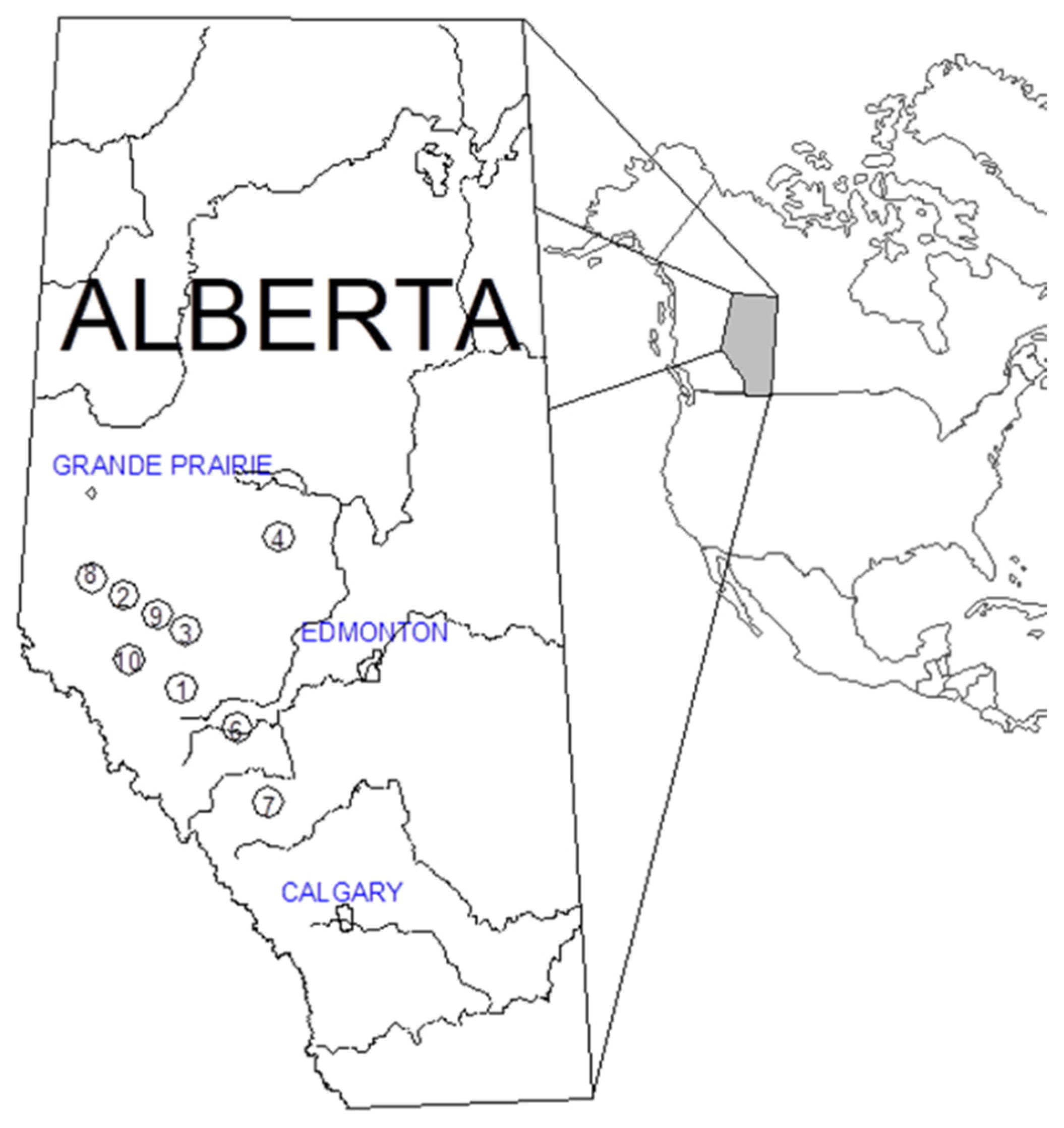
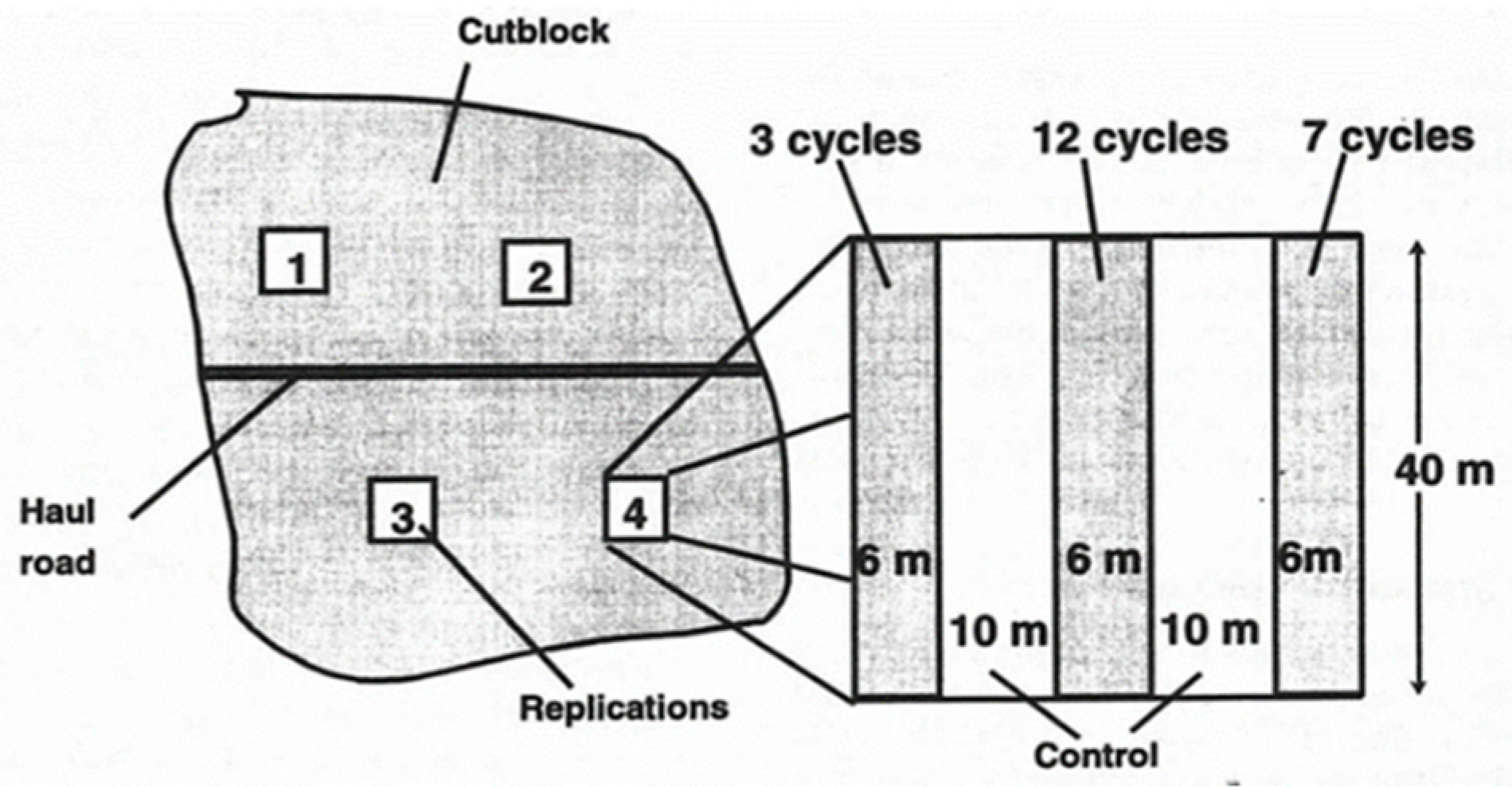
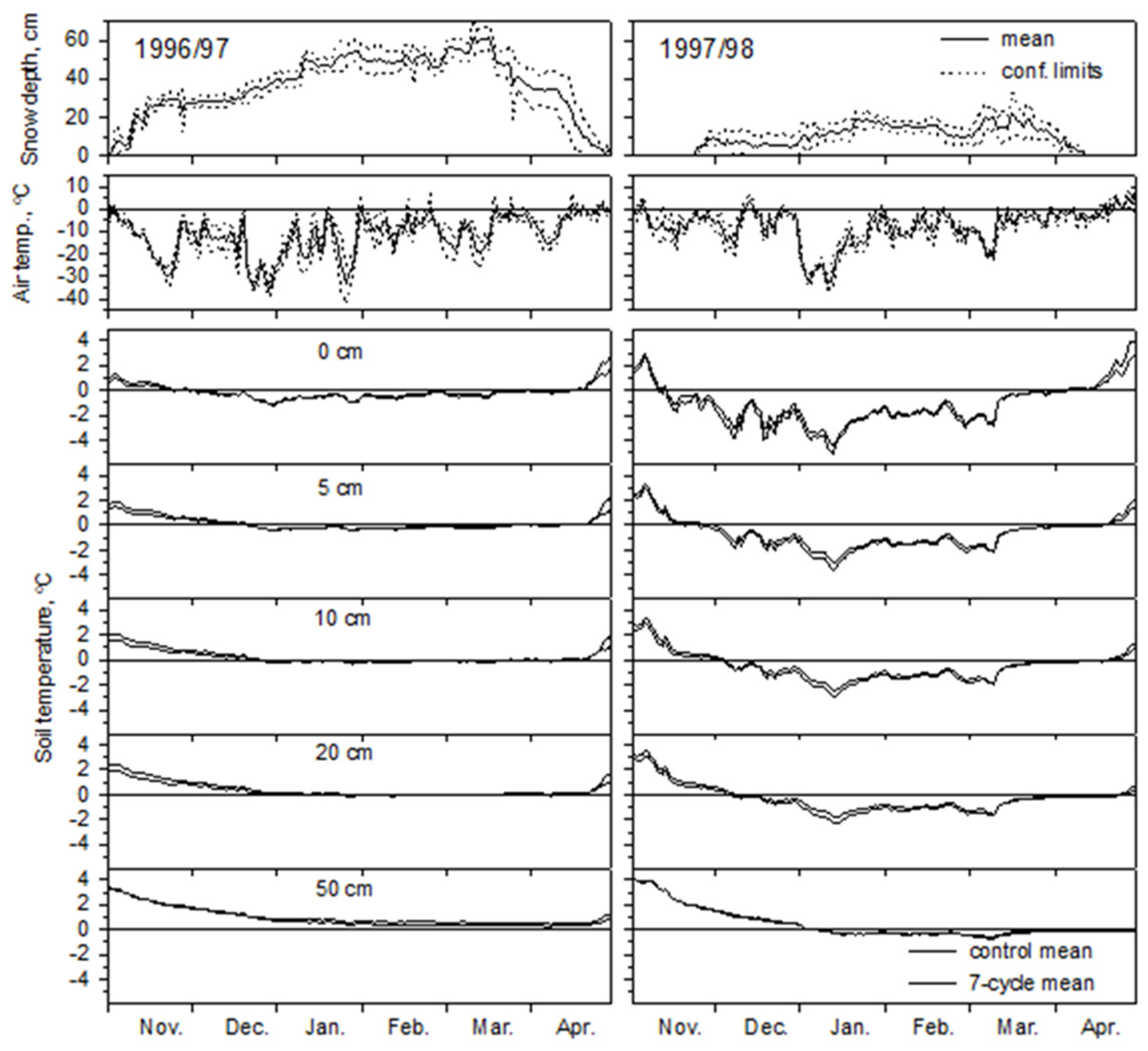
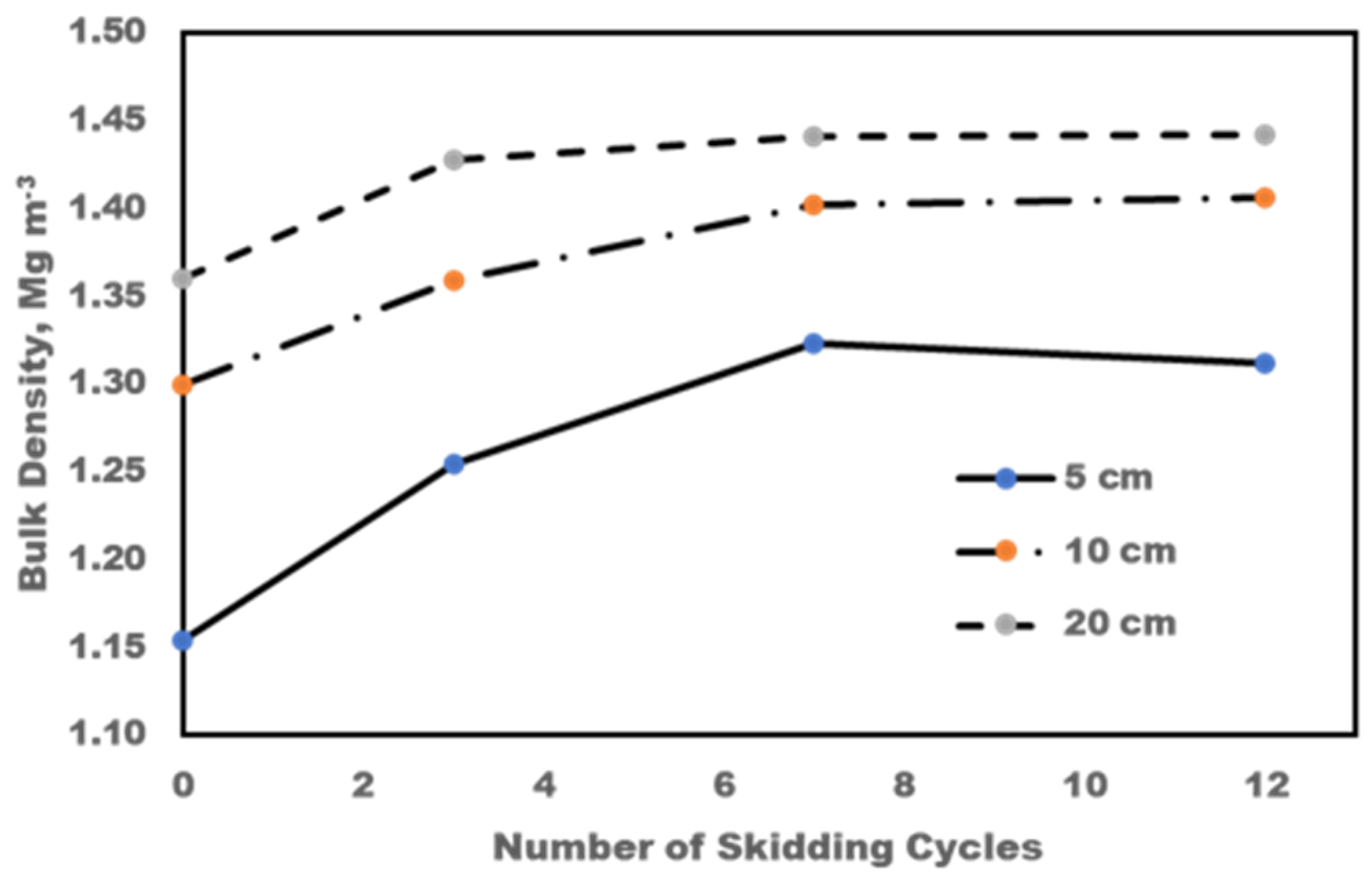
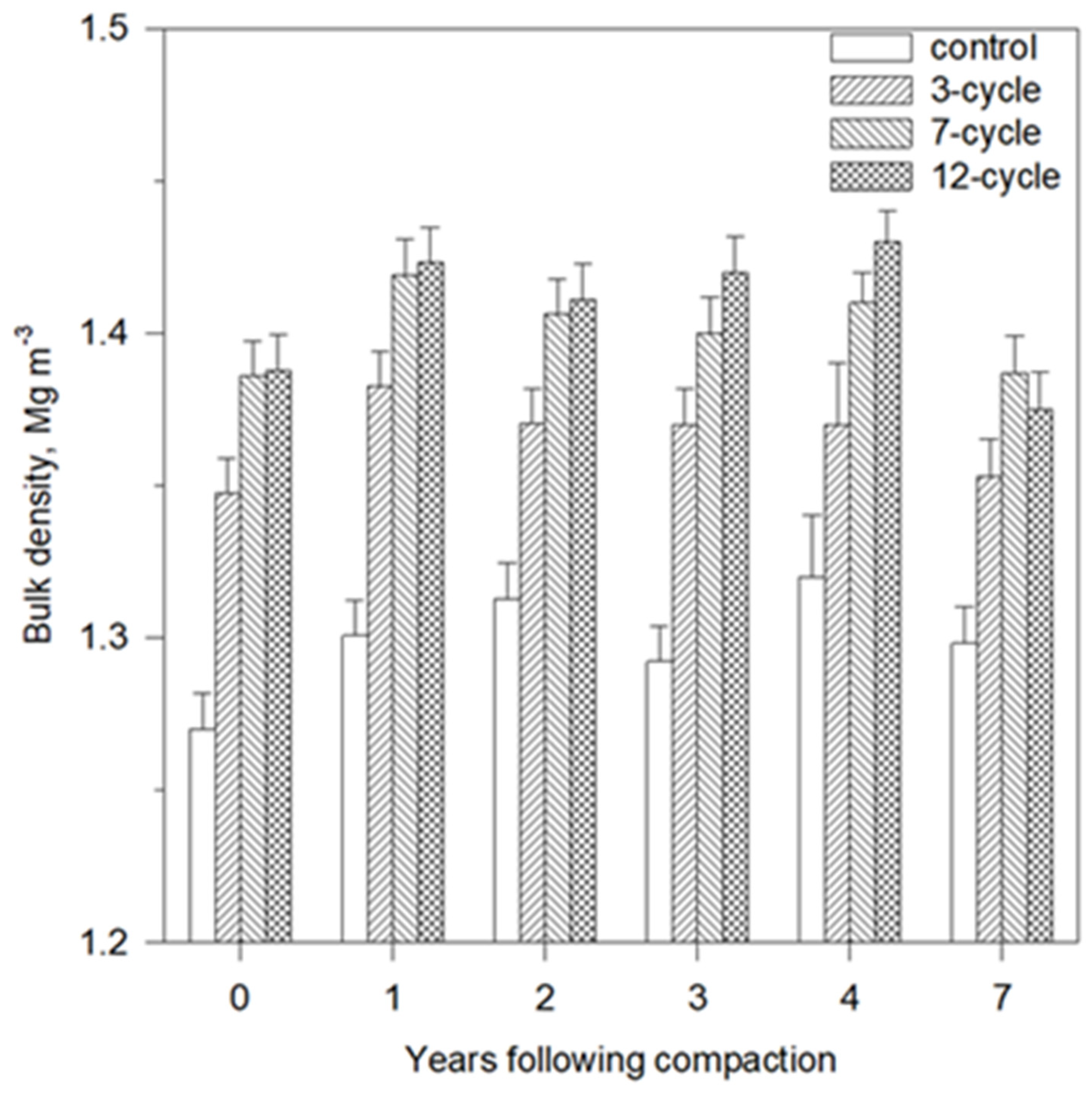
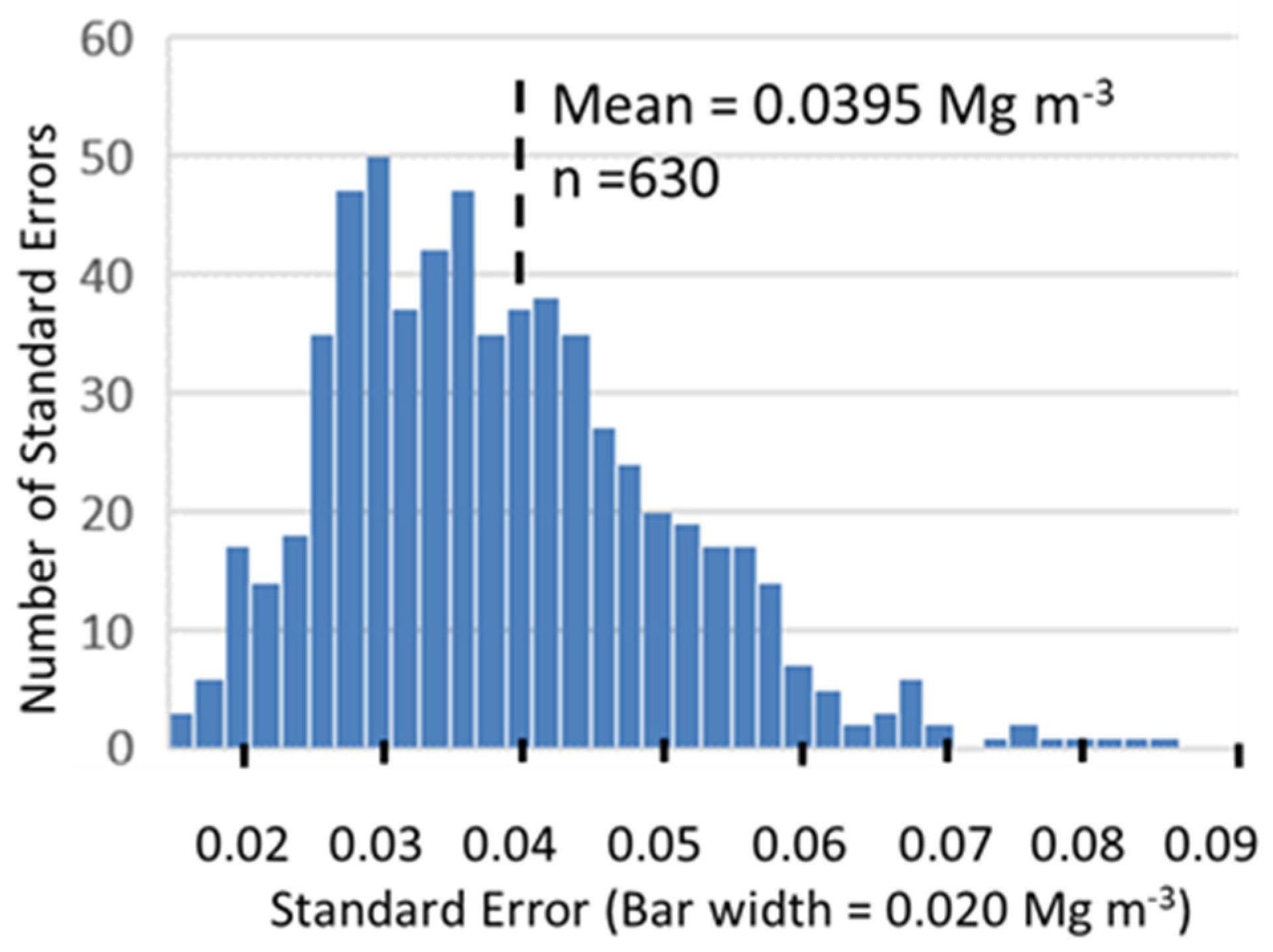
| Site | Depth | Organic Matter | Particle Size Distribution | Texture | Classification | Soil Water When Skidded | TireTrack Width | |||
|---|---|---|---|---|---|---|---|---|---|---|
| Clay | Silt | Sand | ||||||||
| cm | kg kg−1 | kg kg−1 | kPa | m | ||||||
| 1 | 5 | 0.023 | 0.16 | 0.5 | 0.34 | Silt loam/loam | Orthic/Gleyed Gray Luvisol | 0.264 | −13 | 0.8/1.1 |
| 10 | 0.036 | 0.13 | 0.52 | 0.35 | Silt loam/loam | 0.218 | −15 | |||
| 20 | 0.006 | 0.16 | 0.43 | 0.41 | Loam | 0.181 | −15 | |||
| 2 | 5 | 0.025 | 0.17 | 0.64 | 0.19 | Silt loam | Gleyed Gray Luvisol | 0.251 | −15 | 0.7 |
| 10 | 0.028 | 0.19 | 0.59 | 0.22 | Silt loam | 0.234 | −7 | |||
| 20 | 0.015 | 0.23 | 0.59 | 0.18 | Silt loam | 0.259 | −8 | |||
| 3 | 5 | 0.031 | 0.12 | 0.53 | 0.35 | Silt loam | Orthic Gray Luvisol | 0.251 | −6 | 0.8/1.1 |
| 10 | 0.026 | 0.12 | 0.51 | 0.37 | Silt loam | 0.234 | −7 | |||
| 20 | 0.014 | 0.15 | 0.48 | 0.37 | Loam | 0.259 | −7 | |||
| 4 | 5 | 0.024 | 0.21 | 0.43 | 0.36 | Loam | Orthic Gray Luvisol | 0.337 | −9 | 1.1 |
| 10 | 0.031 | 0.2 | 0.4 | 0.4 | Loam | 0.295 | −6 | |||
| 20 | 0.01 | 0.23 | 0.38 | 0.39 | Loam | 0.271 | −7 | |||
| 6 | 5 | 0.027 | 0.15 | 0.44 | 0.41 | Loam | Brunisolic Gray Luvisol | 0.293 | −23 | 0.8 |
| 12 | 0.026 | 0.13 | 0.42 | 0.45 | Loam | 0.234 | −30 | |||
| 20 | 0.008 | 0.17 | 0.39 | 0.44 | Loam | 0.231 | −38 | |||
| 7 | 5 | 0.033 | 0.22 | 0.56 | 0.22 | Silt loam | Eluviated Dystric Brunisol | 0.26 | −7 | 1.1 |
| 10 | 0.027 | 0.21 | 0.55 | 0.24 | Silt loam | 0.23 | −13 | |||
| 20 | 0.012 | 0.28 | 0.52 | 0.2 | Silty clay loam/clay loam | 0.189 | −10 | |||
| 8 | 5 | 0.025 | 0.29 | 0.47 | 0.27 | Clay loam | Orthic/Gleyed Gray Luvisol | 0.448 | −40 | 1.1 |
| 10 | 0.022 | 0.31 | 0.46 | 0.32 | Clay loam | 0.306 | −37 | |||
| 20 | 0.016 | 0.24 | 0.44 | 0.27 | Silt loam | 0.232 | −26 | |||
| 9 | 5 | 0.058 | 0.18 | 0.55 | 0.28 | Silt loam | Orthic Gray Luvisol | 0.229 | −13 | 0.8/1.1 |
| 10 | 0.026 | 0.15 | 0.54 | 0.27 | Silt loam | 0.184 | −16 | |||
| 20 | 0.016 | 0.18 | 0.55 | 0.24 | Silt loam | 0.184 | −15 | |||
| 10 | 5 | 0.028 | 0.25 | 0.5 | 0.25 | Silt loam/loam | Orthic/Gleyed Gray Luvisol | 0.278 | −7 | 0.8 |
| 10 | 0.015 | 0.47 | 0.27 | Loam | 0.222 | −11 | ||||
| 20 | 0.01 | 0.33 | 0.43 | 0.24 | Clay loam | 0.219 | −9 | |||
| Site/Year | Soil Depth, 5 cm | Soil Depth, 10 cm | Soil Depth, 20 cm | |||||||||
|---|---|---|---|---|---|---|---|---|---|---|---|---|
| Control | 3 Cycle | 7 Cycle | 12 Cycle | Control | 3 Cycle | 7 Cycle | 12 Cycle | Control | 3 Cycle | 7 Cycle | 12 Cycle | |
| Mg m−3 | ||||||||||||
| Site 1 | ||||||||||||
| 0 | 1.13 (0.04) | 1.29 (0.04) | 1.33 (0.04) | 1.29 (0.04) | 1.34 (0.04) | 1.46 (0.04) | 1.44 (0.04) | 1.44 (0.03) | 1.46 (0.02) | 1.46 (0.03) | 1.41 (0.04) | 1.47 (0.03) |
| 1 | 1.20 (0.04) | 1.24 (0.04) | 1.35 (0.04) | 1.36 (0.03) | 1.37 (0.06) | 1.52 (0.04) | 1.51 (0.03) | 1.49 (0.03) | 1.48 (0.04) | 1.61 (0.02) | 1.58 (0.02) | 1.58 (0.02) |
| 2 | 1.12 (0.04) | 1.07 (0.05) | 1.14 (0.04) | 1.19 (0.04) | 1.28 (0.03) | 1.30 (0.05) | 1.36 (0.05) | 1.34 (0.04) | 1.39 (0.03) | 1.39 (0.03) | 1.38 (0.03) | 1.36 (0.03) |
| 3 | 1.09 (0.04) | 1.12 (0.07) | 1.27 (0.05) | 1.26 (0.04) | 1.29 (0.03) | 1.40 (0.05) | 1.46 (0.04) | 1.44 (0.04) | 1.46 (0.03) | 1.46 (0.04) | 1.50 (0.04) | 1.45 (0.02) |
| 4 | 1.20 (0.05) | 1.1 (0.05) | 1.30 (0.04) | 1.28 (0.05) | 1.48 (0.03) | 1.45 (0.05) | 1.42 (0.05) | 1.43 (0.06) | 1.58 (0.02) | 1.58 (0.04) | 1.54 (0.03) | 1.51 (0.04) |
| 7 | 1.14 (0.03) | 1.09 (0.04) | 1.14 (0.04) | 1.15 (0.05) | 1.22 (0.03) | 1.19 (0.04) | 1.28 (0.03) | 1.27 (0.04) | 1.27 (0.03) | 1.24 (0.05) | 1.29 (0.03) | 1.15 (0.06) |
| Site 2 | ||||||||||||
| 0 | 1.29 (0.05) | 1.34 (0.05) | 1.40 (0.04) | 1.46 (0.04) | 1.37 (0.04) | 1.38 (0.04) | 1.41 (0.03) | 1.42 (0.04) | 1.29 (0.05) | 1.40 (0.04) | 1.38 (0.03) | 1.41 (0.04) |
| 1 | 1.20 (0.04) | 1.39 (0.04) | 1.34 (0.05) | 1.42 (0.03) | 1.23 (0.04) | 1.41 (0.04) | 1.43 (0.03) | 1.39 (0.04) | 1.30 (0.04) | 1.35 (0.05) | 1.43 (0.03) | 1.42 (0.04) |
| 2 | 1.18 (0.04) | 1.26 (0.06) | 1.33 (0.03) | 1.35 (0.05) | 1.30 (0.05) | 1.38 (0.04) | 1.45 (0.03) | 1.40 (0.04) | 1.33 (0.04) | 1.40 (0.05) | 1.42 (0.03) | 1.44 (0.04) |
| 3 | 1.31 (0.05) | 1.36 (0.05) | 1.31 (0.03) | 1.43 (0.03) | 1.29 (0.04) | 1.38 (0.04) | 1.40 (0.03) | 1.44 (0.05) | 1.29 (0.03) | 1.38 (0.05) | 1.45 (0.03) | 1.42 (0.04) |
| 4 | 1.24 (0.05) | 1.32 (0.05) | 1.37 (0.03) | 1.38 (0.03) | 1.31 (0.05) | 1.40 (0.04) | 1.43 (0.03) | 1.43 (0.04) | 1.22 (0.04) | 1.33 (0.04) | 1.44 (0.04) | 1.42 (0.05) |
| 7 | 1.03 (0.06) | 1.16 (0.05) | 1.27 (0.03) | 1.25 (0.03) | 1.13 (0.04) | 1.31 (0.04) | 1.35 (0.03) | 1.30 (0.03) | 1.16 (0.05) | 1.27 (0.05) | 1.31 (0.04) | 1.33 (0.03) |
| Site 3 | ||||||||||||
| 0 | 1.19 (0.06) | 1.27 (0.04) | 1.39 (0.04) | 1.37 (0.03) | 1.31 (0.03) | 1.42 (0.03) | 1.47 (0.04) | 1.48 (0.03) | 1.35 (0.03) | 1.47 (0.03) | 1.50 (0.04) | 1.51 (0.03) |
| 1 | 1.28 (0.04) | 1.27 (0.05) | 1.27 (0.06) | 1.35 (0.04) | 1.33 (0.03) | 1.37 (0.03) | 1.39 (0.05) | 1.45 (0.03) | 1.40 (0.04) | 1.44 (0.03) | 1.45 (0.04) | 1.54 (0.02) |
| 2 | 1.22 (0.04) | 1.35 (0.05) | 1.33 (0.06) | 1.43 (0.04) | 1.36 (0.04) | 1.45 (0.03) | 1.45 (0.02) | 1.52 (0.03) | 1.47 (0.03) | 1.49 (0.03) | 1.53 (0.03) | 1.59 (0.03) |
| 3 | 1.28 (0.03) | 1.24 (0.07) | 1.35 (0.06) | 1.44 (0.03) | 1.33 (0.03) | 1.48 (0.05) | 1.44 (0.03) | 1.50 (0.03) | 1.40 (0.03) | 1.54 (0.05) | 1.50 (0.04) | 1.60 (0.03) |
| 4 | 1.17 (0.05) | 1.27 (0.03) | 1.35 (0.06) | 1.41 (0.03) | 1.31 (0.04) | 1.37 (0.04) | 1.43 (0.03) | 1.45 (0.04) | 1.37 (0.03) | 1.44 (0.04) | 1.51 (0.03) | 1.58 (0.02) |
| 7 | 1.32 (0.05) | 1.48 (0.06) | 1.42 (0.06) | 1.46 (0.05) | 1.49 (0.03) | 1.50 (0.04) | 1.56 (0.05) | 1.53 (0.04) | 1.50 (0.02) | 1.52 (0.03) | 1.59 (0.04) | 1.61 (0.03) |
| Site 4 | ||||||||||||
| 0 | 1.21 (0.04) | 1.38 (0.05) | 1.39 (0.03) | 1.42 (0.04) | 1.39 (0.02) | 1.39 (0.04) | 1.46 (0.03) | 1.47 (0.03) | 1.38 (0.04) | 1.43 (0.04) | 1.46 (0.02) | 1.50 (0.02) |
| 1 | 1.27 (0.03) | 1.33 (0.06) | 1.46 (0.03) | 1.41 (0.04) | 1.39 (0.03) | 1.49 (0.02) | 1.49 (0.03) | 1.57 (0.04) | 1.39 (0.03) | 1.46 (0.03) | 1.51 (0.03) | 1.57 (0.03) |
| 2 | 1.30 (0.03) | 1.30 (0.03) | 1.36 (0.05) | 1.27 (0.06) | 1.35 (0.03) | 1.40 (0.03) | 1.43 (0.04) | 1.54 (0.02) | 1.41 (0.03) | 1.42 (0.03) | 1.54 (0.04) | 1.53 (0.03) |
| 3 | 1.27 (0.05) | 1.33 (0.04) | 1.38 (0.05) | 1.39 (0.04) | 1.35 (0.04) | 1.46 (0.03) | 1.52 (0.02) | 1.52 (0.03) | 1.38 (0.04) | 1.47 (0.03) | 1.49 (0.02) | 1.53 (0.03) |
| 4 | 1.27 (0.04) | 1.28 (0.03) | 1.38 (0.04) | 1.36 (0.05) | 1.34 (0.03) | 1.43 (0.04) | 1.50 (0.02) | 1.46 (0.09) | 1.39 (0.02) | 1.49 (0.03) | 1.50 (0.03) | 1.57 (0.02) |
| 7 | 1.24 (0.04) | 1.28 (0.05) | 1.33 (0.04) | 1.32 (0.05) | 1.27 (0.03) | 1.33 (0.04) | 1.42 (0.03) | 1.45 (0.04) | 1.29 (0.04) | 1.32 (0.03) | 1.40 (0.03) | 1.43 (0.03) |
| Site 6 | ||||||||||||
| 0 | 1.08 (0.06) | 1.16 (0.06) | 1.31 (0.05) | 1.14 (0.05) | 1.22 (0.05) | 1.34 (0.05) | 1.30 (0.07) | 1.32 (0.04) | 1.31 (0.03) | 1.43 (0.04) | 1.45 (0.04) | 1.41 (0.06) |
| 1 | 1.05 (0.04) | 1.20 (0.06) | 1.13 (0.05) | 1.17 (0.07) | 1.31 (0.04) | 1.35 (0.04) | 1.33 (0.05) | 1.36 (0.04) | 1.34 (0.05) | 1.42 (0.02) | 1.47 (0.03) | 1.45 (0.03) |
| 2 | 1.22 (0.04) | 1.18 (0.05) | 1.30 (0.05) | 1.23 (0.05) | 1.35 (0.03) | 1.29 (0.05) | 1.42 (0.04) | 1.30 (0.03) | 1.37 (0.02) | 1.37 (0.03) | 1.40 (0.04) | 1.31 (0.03) |
| 3 | 1.09 (0.05) | 1.14 (0.05) | 1.11 (0.05) | 1.11 (0.05) | 1.25 (0.04) | 1.27 (0.04) | 1.27 (0.06) | 1.30 (0.05) | 1.39 (0.03) | 1.41 (0.02) | 1.41 (0.03) | 1.49 (0.03) |
| 4 | 1.08 (0.04) | 1.08 (0.04) | 1.12 (0.06) | 1.19 (0.06) | 1.26 (0.04) | 1.22 (0.05) | 1.32 (0.04) | 1.28 (0.04) | 1.41 (0.02) | 1.47 (0.03) | 1.50 (0.02) | 1.42 (0.05) |
| 7 | 1.24 (0.04) | 1.24 (0.04) | 1.22 (0.05) | 1.22 (0.04) | 1.35 (0.02) | 1.37 (0.02) | 1.38 (0.03) | 1.34 (0.04) | 1.36 (0.03) | 1.37 (0.02) | 1.43 (0.04) | 1.36 (0.06) |
| Site 7 | ||||||||||||
| 0 | 1.00 (0.05) | 1.12 (0.05) | 1.18 (0.04) | 1.22 (0.06) | 1.25 (0.06) | 1.23 (0.03) | 1.28 (0.05) | 1.36 (0.05) | 1.43 (0.03) | 1.45 (0.05) | 1.44 (0.05) | 1.47 (0.05) |
| 1 | 1.05 (0.04) | 1.20 (0.06) | 1.21 (0.06) | 1.30 (0.07) | 1.30 (0.05) | 1.35 (0.05) | 1.42 (0.06) | 1.43 (0.04) | 1.43 (0.05) | 1.49 (0.02) | 1.56 (0.03) | 1.50 (0.04) |
| 2 | 1.14 (0.05) | 1.27 (0.04) | 1.23 (0.07) | 1.33 (0.08) | 1.33 (0.05) | 1.39 (0.05) | 1.39 (0.06) | 1.46 (0.04) | 1.48 (0.04) | 1.53 (0.03) | 1.51 (0.04) | 1.55 (0.03) |
| 3 | 1.03 (0.04) | 1.20 (0.06) | 1.14 (0.06) | 1.27 (0.05) | 1.32 (0.05) | 1.45 (0.04) | 1.38 (0.06) | 1.44 (0.07) | 1.51 (0.02) | 1.50 (0.04) | 1.49 (0.04) | 1.53 (0.04) |
| 4 | 0.99 0.04) | 1.21 (0.06) | 1.19 (0.06) | 1.35 (0.06) | 1.27 (0.05) | 1.44 (0.04) | 1.48 (0.05) | 1.47 (0.04) | 1.44 (0.04) | 1.47 (0.04) | 1.56 (0.02) | 1.51 (0.03) |
| 7 | 1.27 (0.05) | 1.27 (0.06) | 1.29 (0.06) | 1.31 (0.05) | 1.35 (0.03) | 1.37 (0.05) | 1.47 (0.05) | 1.49 (0.05) | 1.40 (0.05) | 1.39 (0.04) | 1.48 (0.03) | 1.48 (0.04) |
| Site 8 | ||||||||||||
| 0 | 1.15 (0.06) | 1.15 (0.07) | 1.31 (0.06) | 1.28 (0.05) | 1.33 (0.05) | 1.36 (0.03) | 1.45 (0.05) | 1.38 (0.02) | 1.39 (0.04) | 1.43 (0.03) | 1.45 (0.02) | 1.37 (0.03) |
| 1 | 1.41 (0.04) | 1.37 (0.03) | 1.49 (0.04) | 1.39 (0.04) | 1.55 (0.03) | 1.51 (0.04) | 1.55 (0.02) | 1.51 (0.03) | 1.53 (0.03) | 1.49 (0.03) | 1.49 (0.02) | 1.47 (0.02) |
| 2 | 1.38 (0.05) | 1.37 (0.06) | 1.50 (0.03) | 1.40 (0.04) | 1.52 (0.03) | 1.55 (0.04) | 1.59 (0.02) | 1.54 (0.02) | 1.58 (0.03) | 1.56 (0.03) | 1.59 (0.03) | 1.54 (0.02) |
| 3 | 1.15 (0.07) | 1.33 (0.06) | 1.36 (0.04) | 1.36 (0.06) | 1.44 (0.05) | 1.54 (0.03) | 1.50 (0.04) | 1.50 (0.04) | 1.54 (0.03) | 1.47 (0.04) | 1.52 (0.03) | 1.49 (0.03) |
| 4 | 1.48 (0.03) | 1.44 (0.04) | 1.38 (0.05) | 1.39 (0.04) | 1.56 (0.03) | 1.56 (0.03) | 1.46 (0.05) | 1.59 (0.02) | 1.54 (0.03) | 1.50 (0.04) | 1.48 (0.02) | 1.51 (0.02) |
| 7 | 1.49 (0.05) | 1.50 (0.07) | 1.43 (0.04) | 1.49 (0.04) | 1.52 (0.03) | 1.61 (0.04) | 1.51 (0.03) | 1.56 (0.02) | 1.61 (0.03) | 1.55 (0.03) | 1.50 (0.02) | 1.55 (0.02) |
| Site 9 | ||||||||||||
| 0 | 1.24 (0.05) | 1.27 (0.05) | 1.29 (0.06) | 1.32 (0.07) | 1.30 (0.04) | 1.29 (0.03) | 1.38 (0.04) | 1.36 (0.03) | 1.35 (0.04) | 1.34 (0.03) | 1.42 (0.03) | 1.44 (0.04) |
| 1 | 1.24 (0.04) | 1.29 (0.03) | 1.32 (0.04) | 1.29 (0.08) | 1.29 (0.05) | 1.33 (0.04) | 1.44 (0.03) | 1.34 (0.07) | 1.32 (0.03) | 1.39 (0.02) | 1.47 (0.04) | 1.45 (0.03) |
| 2 | 1.28 (0.05) | 1.38 (0.02) | 1.36 (0.05) | 1.41 (0.03) | 1.29 (0.04) | 1.35 (0.04) | 1.41 (0.04) | 1.40 (0.05) | 1.31 (0.03) | 1.40 (0.04) | 1.46 (0.04) | 1.48 (0.03) |
| 3 | 1.22 (0.08) | 1.06 (0.14) | 1.35 (0.04) | 1.08 (0.15) | 1.28 (0.09) | 1.17 (0.12) | 1.38 (0.02) | 1.24 (0.14) | 1.37 (0.08) | 1.34 (0.08) | 1.49 (0.03) | 1.29 (0.13) |
| 4 | 1.30 (0.05) | 1.30 (0.04) | 1.39 (0.04) | 1.43 (0.03) | 1.27 (0.03) | 1.33 (0.03) | 1.40 (0.04) | 1.49 (0.03) | 1.30 (0.03) | 1.33 (0.04) | 1.44 (0.03) | 1.49 (0.03) |
| 7 | 1.34 (0.04) | 1.41 (0.03) | 1.45 (0.04) | 1.31 (0.03) | 1.37 (0.04) | 1.39 (0.02) | 1.50 (0.04) | 1.44 (0.05) | 1.43 (0.03) | 1.43 (0.04) | 1.46 (0.06) | 1.57 (0.05) |
| Site 10 | ||||||||||||
| 0 | 1.09 (0.05) | 1.30 (0.04) | 1.30 (0.03) | 1.31 (0.03) | 1.18 (0.04) | 1.35 (0.03) | 1.41 (0.02) | 1.42 (0.03) | 1.27 (0.03) | 1.42 (0.03) | 1.44 (0.02) | 1.39 (0.03) |
| 1 | 1.08 (0.03) | 1.28 (0.03) | 1.36 (0.03) | 1.35 (0.04) | 1.12 (0.03) | 1.37 (0.03) | 1.39 (0.02) | 1.46 (0.03) | 1.28 (0.03) | 1.43 (0.03) | 1.50 (0.02) | 1.42 (0.03) |
| 2 | 1.10 (0.04) | 1.32 (0.03) | 1.33 (0.04) | 1.34 (0.03) | 1.19 (0.03) | 1.36 (0.03) | 1.40 (0.03) | 1.46 (0.03) | 1.32 (0.02) | 1.45 (0.02) | 1.49 (0.02) | 1.44 (0.03) |
| 3 | 1.12 (0.04) | 1.32 (0.03) | 1.39 (0.03) | 1.32 (0.04) | 1.19 (0.05) | 1.43 (0.03) | 1.43 (0.02) | 1.45 (0.02) | 1.29 (0.02) | 1.44 (0.03) | 1.50 (0.02) | 1.44 (0.03) |
| 4 | Site was not sampled | |||||||||||
| 7 | 1.04 (0.03) | 1.16 (0.03) | 1.22 (0.06) | 1.05 (0.06) | 1.13 (0.03) | 1.38 (0.03) | 1.42 (0.02) | 1.41 (0.02) | 1.19 (0.03) | 1.37 (0.03) | 1.40 (0.03) | 1.38 (0.02) |
| Source of Variance | Degrees of Freedom | Type III F | Pr > F | Significance Level |
|---|---|---|---|---|
| Traffic Cycles | 3 | 32.71 | 0.0000 | **** |
| Depth | 2 | 801.82 | 0.0000 | **** |
| Site | 8 | 13.91 | 0.0000 | **** |
| Year | 5 | 11.26 | 0.0000 | **** |
| Traffic Cycles * Depth | 6 | 2.36 | 0.0300 | * |
| Traffic Cycles * Site | 24 | 1.32 | 0.1720 | |
| Traffic Cycles * Year | 6 | 1.49 | 0.1976 | |
| Depth * Site | 16 | 20.42 | 0.0000 | **** |
| Depth * Year | 10 | 2.71 | 0.0027 | ** |
| Site * Year | 39 | 14.91 | 0.0000 | **** |
| Traffic Cycles * Depth * Site | 48 | 1.43 | 0.0442 | * |
| Traffic Cycles * Depth * Year | 30 | 0.78 | 0.7903 | |
| Traffic Cycles * Site * Year | 117 | 1.21 | 0.0889 | |
| Depth * Site * Year | 78 | 1.98 | 0.0000 | **** |
| Statistic | 5 cm Depth | 10 cm Depth | 20 cm Depth | Combined Depths |
|---|---|---|---|---|
| Mean | 0.0463 | 0.0391 | 0.0333 | 0.0395 |
| Median | 0.0441 | 0.0363 | 0.0310 | 0.0370 |
| Standard Error | 0.0010 | 0.0010 | 0.0008 | 0.0006 |
| Standard Deviation | 0.0151 | 0.0147 | 0.0117 | 0.149 |
| Kurtosis | 14.9592 | 15.7848 | 20.2396 | 13.4195 |
| Skewness | 2.71672 | 2.9093 | 3.1446 | 2.5526 |
| Range | 0.1288 | 0.1270 | 0.1106 | 0.1328 |
| Minimum | 0.0205 | 0.0170 | 0.0165 | 0.0165 |
| Maximum | 0.1493 | 0.1440 | 0.1272 | 0.1493 |
| Count | 210 | 210 | 210 | 630 |
Publisher’s Note: MDPI stays neutral with regard to jurisdictional claims in published maps and institutional affiliations. |
© 2022 by the authors. Licensee MDPI, Basel, Switzerland. This article is an open access article distributed under the terms and conditions of the Creative Commons Attribution (CC BY) license (https://creativecommons.org/licenses/by/4.0/).
Share and Cite
McNabb, D.H.; Startsev, A. Seven-Year Changes in Bulk Density Following Forest Harvesting and Machine Trafficking in Alberta, Canada. Forests 2022, 13, 553. https://doi.org/10.3390/f13040553
McNabb DH, Startsev A. Seven-Year Changes in Bulk Density Following Forest Harvesting and Machine Trafficking in Alberta, Canada. Forests. 2022; 13(4):553. https://doi.org/10.3390/f13040553
Chicago/Turabian StyleMcNabb, David H., and Andrei Startsev. 2022. "Seven-Year Changes in Bulk Density Following Forest Harvesting and Machine Trafficking in Alberta, Canada" Forests 13, no. 4: 553. https://doi.org/10.3390/f13040553
APA StyleMcNabb, D. H., & Startsev, A. (2022). Seven-Year Changes in Bulk Density Following Forest Harvesting and Machine Trafficking in Alberta, Canada. Forests, 13(4), 553. https://doi.org/10.3390/f13040553





